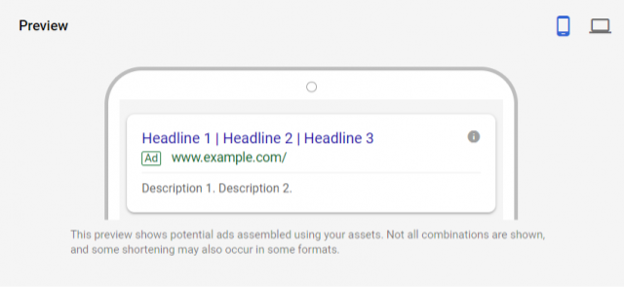
Before making a major purchase these days, most people spend some time online, conducting research and gathering information to help them with their purchase decision. As you can expect, buyers in the B2B market follow a similar process. In fact, according to Gartner, B2B buyers spend 30% of their buying time researching independently online. With Google controlling about 92% of the search engine market share worldwide, it’s fair to say that when it comes to searching for information online, “Google is — by far — the digital frontrunner.” (HubSpot)
.png?width=760&height=398&name=5%20second%20summary%20(1).png)
Since there is a high probability that your potential B2B customers are already searching with Google, running a Google Search Ads campaign as part of your marketing strategy makes perfect sense. We’ve put together some beginner guidelines with all the essentials you’ll need to set up your first Google Search Ads campaign.
What is Google Ads?
Google Ads is the name of Google’s online advertising platform. When your target audience uses Google search to look up products and services similar to the ones you offer, your ads can show up on the search engine results page if you are running a paid Google Ads campaign. Google Ads is a pay-per-click program where you pay per click/impression on your ad. This gives you the ability to customize a campaign to fit your budget.
Guidelines for your first Google Search Ads campaign
1. Set a goal for your ad campaign
Determine a goal to align with the main objective you want to achieve from your campaign. Do you want to raise awareness of your new IT service? Or maybe you want to increase traffic to your recent blog? Selecting a specific goal (such as driving website traffic) will guide Google Ads to recommend specific features and settings that are designed to help your campaign succeed.
2. Select a topic for your ads
Since you are working in the IT industry, it’s a good idea to select a specific product or solution to highlight in your ad. For example, if you are an IBM Business Partner, then perhaps you want your ads to focus on IBM Power Systems. If you are a NetApp partner, your ads could discuss NetApp FlexPod. Or maybe you want the ads to focus on your own capabilities as an IT Solutions Provider. Take some time to think about the specific challenges and questions that your target audience may have and choose an ad topic that will entice them.
3. Choose the destination that your ads will lead to
Ideally, your advertisements will lead to a relevant page on your website. For example, your ad could link to a specific Service or Product page, a recent blog you want to promote, or simply your website homepage. Whichever page you decide to link your ads to, ensure that it:
- loads quickly to provide an optimal experience
- has simple navigation with information that matches exactly with what visitors searched for
- provides easy to use forms if you’re asking visitors to share information before getting access to resources
- adds credibility to your brand with a clean and professional quality site and includes business contact information that is easy to find
4. Determine the geographical area your ads will target
Location targeting in Google Ads enables you to showcase your ads to people in a particular geographical region. For example, do you want people all over the world to see your ads, or just people in Canada and/or the USA?
Depending on your product or service, supporting customers from around the globe may not be possible. If this is the case, you would want to target a geographical area that is relevant to your business, to prevent your ads from being shown to people in regions you cannot support. This approach not only helps you minimize costs and maximize your return on investment, but it also lets you directly target customers searching locally for your product or service.
5. Build a list of keywords to target and bid on
Creating a list of keywords that your ads will target is arguably the most important element in setting up your Google Search Ads campaign. Come up with a list of target Keywords (words or phrases) that are relevant to the product or service that you are advertising. Once you have specified your target keywords, your ads will be shown to people that have entered those keywords in a Google search.
Choosing high quality, relevant keywords for your campaign can help your ads be seen by the right people. In order for your ads to appear when people search for your product or service, the keywords you choose need to match the words or phrases that people search.
For example, if you want to promote a hybrid cloud blog that you recently published on your website, then you can pull together a list of 150+ related keywords such as “hybrid cloud computing,” “hybrid IT,” or “hybrid cloud architecture” to target in your campaign. When people in your selected geographical area search for a term that matches one of the keywords on your list, then your ad will be shown to them (unless another advertiser outbids you). There are many tools available online that can help you pull keyword reports to pinpoint the best keywords for you to target. Ideally, you would want to target keywords that have high search volumes and low competition.
6. Develop a list of keywords to exclude
To make your ads as efficient as possible and prevent them from showing in particular search results, you should exclude negative and irrelevant keywords. Some examples may include, “Worst HCI provider” or “HCI tv services.” By including a list of negative keywords, you can help ensure that your ads only appear on the searches you want.
7. Create intriguing ad headlines and descriptions
Once you’ve confirmed the product or service you will feature in your ads and the associated list of targeted keywords, your next step is to create some intriguing ad headlines and descriptions.

Headlines will appear at the top of your ad, above a link to your website. They should be short, dynamic, and entice your target audience to read the rest of your ad. Descriptions appear below the link to your website and give you an opportunity to highlight the uniqueness of your business and identify why viewers should visit your website. You should also include a call-to-action in your description. It’s best to develop a variety of ad headlines and descriptions to enable you to perform effective A/B testing. Google recommends developing 15 headlines (max. 30 characters including spaces) and 4 descriptions (max. 90 characters including spaces).
Let’s say one of your keywords is Hyper Converged Infrastructure (HCI) and someone does a Google search for “What is Hyper Converged Infrastructure?”, one ad headline could be “Read the HCI eBook” and a description could be, “Learn everything there is to know about HCI for SMB.”
8. Develop an ad budget
Determine how much you are willing to spend on your Google Ads campaign. When you set up your ad budget, this is the average amount you are prepared to spend per day. Due to the extremely competitive market for IT-related keyword searches, we recommend a minimum starting daily budget of $150, with plans to invest at a higher daily budget once initial results start to produce results.
Additional Targeting Capabilities
These Google Search Ad guidelines describe the use of geography and keyword targeting only, but there are many other targeting parameters that can be used including:
- Income level
- Age
- Gender
- Industry
- Company size
- Interests
Since the technology sector is such a niche industry, you don’t want to add too many targeting parameters, otherwise your ads will stall, and you won’t get any impressions or clicks! Ultimately, the number of targeting parameters that you can specify will depend on the search volume of your keywords.
For example, if you are targeting Canada and most of your keywords have very low search traffic (only 30 searches each month or so), then you don’t necessarily want to add additional targeting parameters, as this would stall your ads. But feel free to try out various targeting parameters in your Google Ads to test the results and let us know how it goes in the comments section of this blog!
Interested in finding out more about Google Search Ads? Visit our Digital Advertising page to get started.


.png?width=252&height=82&name=gameplanmktg_logo_white%20(1).png)
